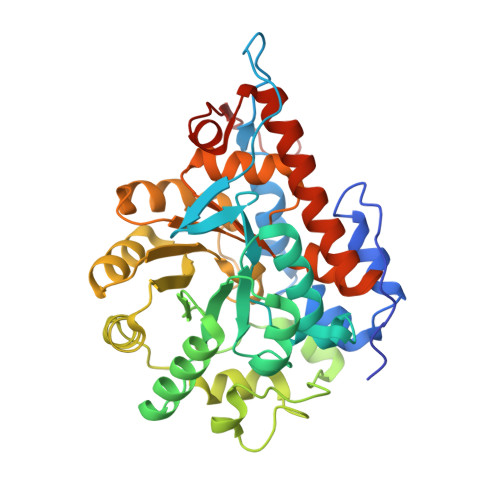Speeding up the product release: a second-sphere contribution from Tyr191 to the reactivity of l-lactate oxidase revealed in crystallographic and kinetic studies of site-directed variants.
Stoisser, T., Klimacek, M., Wilson, D.K., Nidetzky, B.(2015) FEBS J 282: 4130-4140
- PubMed: 26260739
- DOI: https://doi.org/10.1111/febs.13409
- Primary Citation of Related Structures:
4YL2 - PubMed Abstract:
Among α-hydroxy acid-oxidizing flavoenzymes l-lactate oxidase (LOX) is unique in featuring a second-sphere tyrosine (Tyr191 in Aerococcus viridans LOX; avLOX) at the binding site for the substrate's carboxylate group. Y191F, Y191L and Y191A variants of avLOX were constructed to affect a hydrogen-bond network connecting Tyr191 to the carboxylate of the bound ligand via the conserved Tyr40 and to examine consequent effects on enzymatic reactivity. Kinetic studies at 20 °C and pH 6.5 revealed that release of pyruvate product was decreased 4.7-fold (Y191F), 19-fold (Y191L) and 28-fold (Y191A) compared with wild-type enzyme (~ 141 s(-1)) and thus became mainly rate limiting for l-lactate oxidation by the variants at a steady-state under air-saturated conditions. In the Y191L and the Y191A variants, but not in the Y191F variant, l-lactate binding was also affected strongly by the site-directed substitution. Reduction of the flavin cofactor by l-lactate and its reoxidation by molecular oxygen were, however, comparatively weakly affected by the replacements of Tyr191. Unlike the related lactate monooxygenase, which prevents the fast dissociation of pyruvate to promote its oxidative decarboxylation by H2 O2 into acetate, CO2 and water as final reaction products, all avLOX variants retained their native oxidase activity where catalytic turnover results in the equivalent formation of H2O2. The 1.9 Å crystal structure of the Y191F variant bound with FMN and pyruvate revealed a strictly locally disruptive effect of the site-directed substitution. Product off-rates appear to be dictated by partitioning of residues including Tyr191 from an active-site lid loop into bulk solvent and modulation of the hydrogen bond strength that links Tyr40 with the pyruvate's carboxylate group. Overall, this study emphasizes the possibly high importance of contributions from second-sphere substrate-binding residues to the fine-tuning of reactivity in α-hydroxy acid-oxidizing flavoenzymes, requiring that the catalytic steps of flavin reduction and oxidation are properly timed with the physical step of α-keto acid product release.
Organizational Affiliation:
Research Center Pharmaceutical Engineering, Graz, Austria.
















